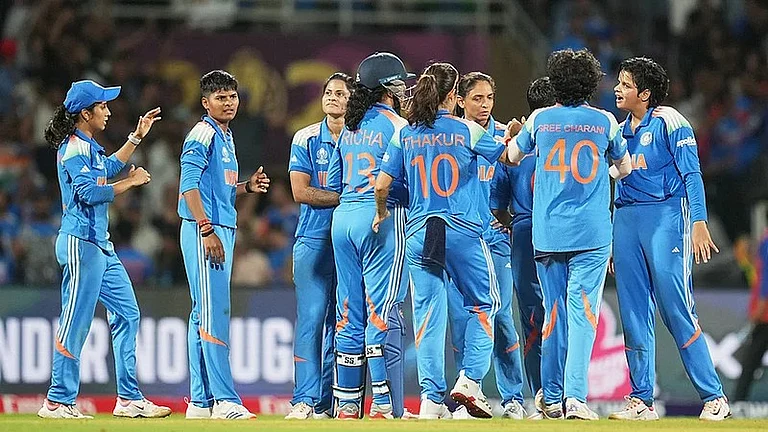Darjeeling, one of India’s most-famous hill stations, is notorious for its traffic jams, especially during the tourist seasons of summer and early winter. Part of it can be blamed on the severe water crisis that the 172-year-old municipal town is battling. Apart from tourist vehicles, hundreds of trucks unload large filled tanks and load empty tanks in front of hotels, clogging the already narrow roads for hours.
Darjeeling gets only one-third of its daily water requirement through municipal pipelines.
“A fleet of 105 trucks ply three or four trips a day from April to June (peak tourist season), carrying 5,500 to 6,500 litres of water on each run,” Mahendra P. Lama and Roshan P. Rai noted in their 2016 research paper, titled Chokho Pani: An Interface Between Religion and Environment in Darjeeling. “Each truckload of water is sold at an average of Rs 1,000. During the rest of the year, about 60 to 65 trucks are in operation every day.”
It was not supposed to be like this. Darjeeling does not have a dearth of water resources. Apart from the town and the district being home to several rivers and many perennial and semi-perennial streams, it is one of the highest rainfall-receiving regions in the Eastern Himalayas.
However, a lack of storage system and colonial-era piped distribution network that is further compromised with leakage, blockage and manipulation due to illegal tapping, has meant more than half the population are forced to buy water from private suppliers. These agents tap natural resources and supply drinking water through narrow and private, illegal pipelines or water tanks and jars.
“There are areas in town where the municipal water comes once or twice a week. Some areas get daily water supply but the force is negligible for most of the time. As a result, people largely depend on buying water,” says Bikash Dewan, a trader living in the Chawk Bazar area. The water supply network is mostly helmed in the town's centre, due to which peripheral areas are supply-deprived.
Outside the municipal area, no government agency supplies any water. Women have to wait in long queues to collect water from streams.
"Every household pays Rs 300 per month to a private water supplier who taps stream water and supplies it to pipelines for 30-40 minutes a day,” says Dhiraj Rasaily, a taxi driver living in Harshing village, Lebong area.
According to a report of the Darjeeling Water Works Department, the town’s daily water requirement is 19,70,000 gallons (89,55,797 litres), but the municipality manages to supply only 6,37,500 gallons (28,98,132 litres), leaving a deficit of 13,32,500 gallons (60,57,665 litres) per day. This excessive deficit is partly because of leakage—nearly 25 per cent of the total production.
Another municipal report said the existing water supply installations centred on the twin lakes at Senchal were meant for a population of about 15,000 people during 1910-15. More installations such as Khangkhola Station, Rambi water line, Sindhap Lake, Bokshi Jhora and Bangla Khola were set up later, but they were never enough for the increase in population, which in 2011 stood over 1.2 lakhs.
“But the crisis during the last few years or so has reached its peak due to a drastic fall in water levels at natural springs in the catchment area due to massive illegal felling of trees,” the report says.
Sherap Bhutia, head of the department of geography at Darjeeling Government College, pointed out that Darjeeling receives nine times higher rainfall than its total water requirement and proper rainwater harvest management can solve the crisis.
“Millions of gallons of water get wasted due to a lack of a proper storage and treatment system. Besides revamping the entire distribution system in the town, the administration needs to arrange for a proper rainwater harvesting system to end the problem,” Bhutiya tells Outlook.
In a 2019 article, titled Understanding the Rainwater Harvesting in Darjeeling Town: An Initiative to Mitigate Water Crisis, Bhutia says the hydrology and terrain conditions indicate that the scope for ground water development is meagre, except for the development of springs.
“But depletion of forests and increase in average run-offs has helped in drying up of many local springs. The only alternative to mitigate the crisis is rainwater harvesting. Rooftop rainwater conservation is the best option, as the steep gradient of the surface restricts the scope for any rainwater conservation from surface runoff,” Bhutia wrote in the article.
Regarding revamping the storage and distribution system, in 2016, the municipality got to take up the biggest project it had ever taken up—the Rs 205 crore project under the Atal Mission for Rejuvenation and Urban Transformation (AMRUT) scheme—to relay all pipes, revamp the whole distribution system and set up 30 water tanks and 14 pump houses. The Union government was to bear half the cost, the state government 45 per cent and for the municipality’s quota of five per cent the state would give them a loan.
However, unavailability of land took the number of reservoirs down to 23. As of mid-2022 the project is far from complete. In fact, one of the first decisions Darjeeling’s new municipal chairman, Ritesh Portel, took after swearing in was to ask the people to send in their grievances and complaints about the quality of work concerning the AMRUT Project.
Following a meeting with the district magistrate on March 22, Portel announced that further work on the project will be on hold till the implementing agencies have resolved the public grievances caused by alleged faulty laying of pipes.
Speaking to Outlook, Mahendra P Lama, a professor at the School of International Studies at Jawaharlal Nehru University, New Delhi, and the founding vice-chancellor of Sikkim University, who is originally from Darjeeling, says that the blame for Darjeeling’s water scarcity is a crisis created by poor management and “should lie squarely on the West Bengal government".
Lama adds the existing distribution system is largely made of what was constructed during the colonial period. "Nothing significant has been added since Independence,” he says. He added that two important interventions had been made, one in the shape of the project to pump water from Balason River and the other is the AMRUT project, but neither project was treated seriously.
“The Balason River Project has been inaugurated thrice but till today, no one has seen even a drop of water from it. In the AMRUT project, the quality of materials used, the execution, the way the pipes have been laid...are all indicative of a forthcoming disaster. The lack of engineering skills displayed by the implementing agencies is beyond imagination. This construction will not last even for a decade,” he says.
For a long-term solution to the problem, Lama adds that the people with greater expertise must be involved in the planning stage.
About solving the crisis outside Darjeeling municipal area, the Gorkhaland Territorial Administration (GTA) had sent a proposal to the Union government for a Rs 750 crore project. Nothing has been heard of it since then. While the GTA board at that time had finished its tenure and the institution was being run by administrators appointed by the state government, the newly elected GTA body is expected to take up the matter.
However, with the Bharatiya Janata Party in Darjeeling boycotting the GTA election and refusing to give the semi-autonomous body any legitimacy, whether the Union government would respond to any fresh proposal for funds from the GTA remains to be seen.


























